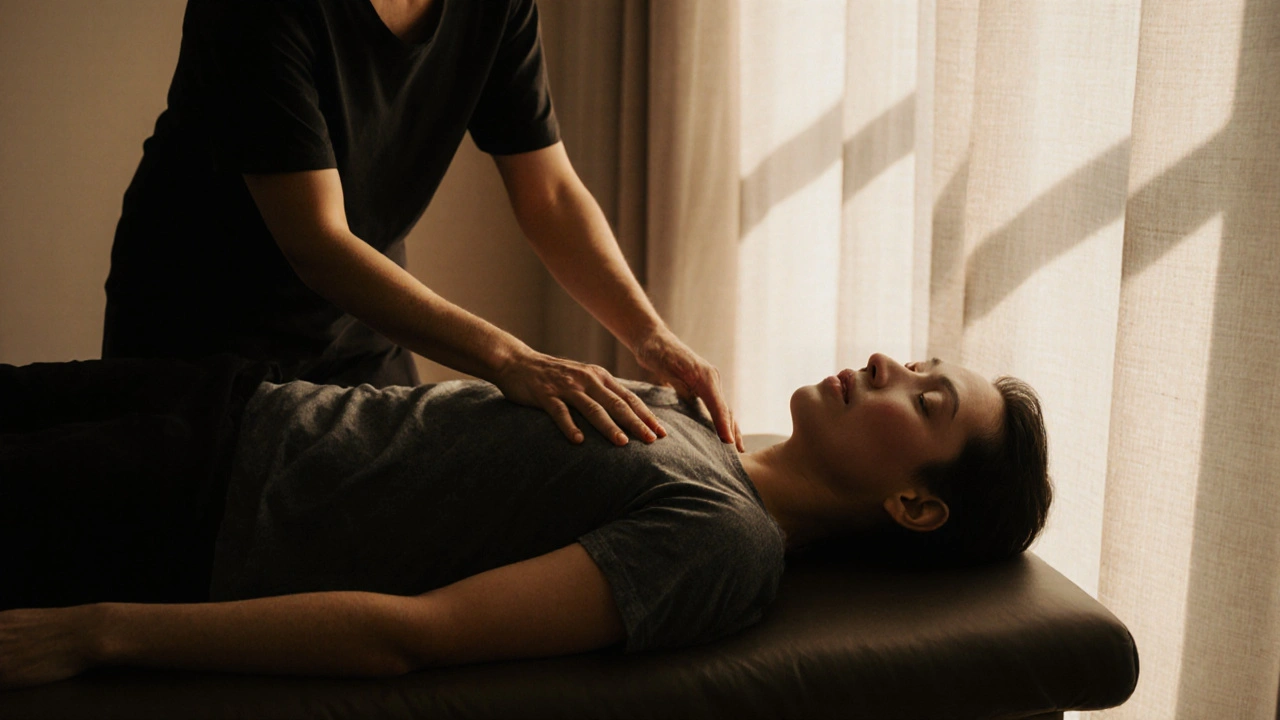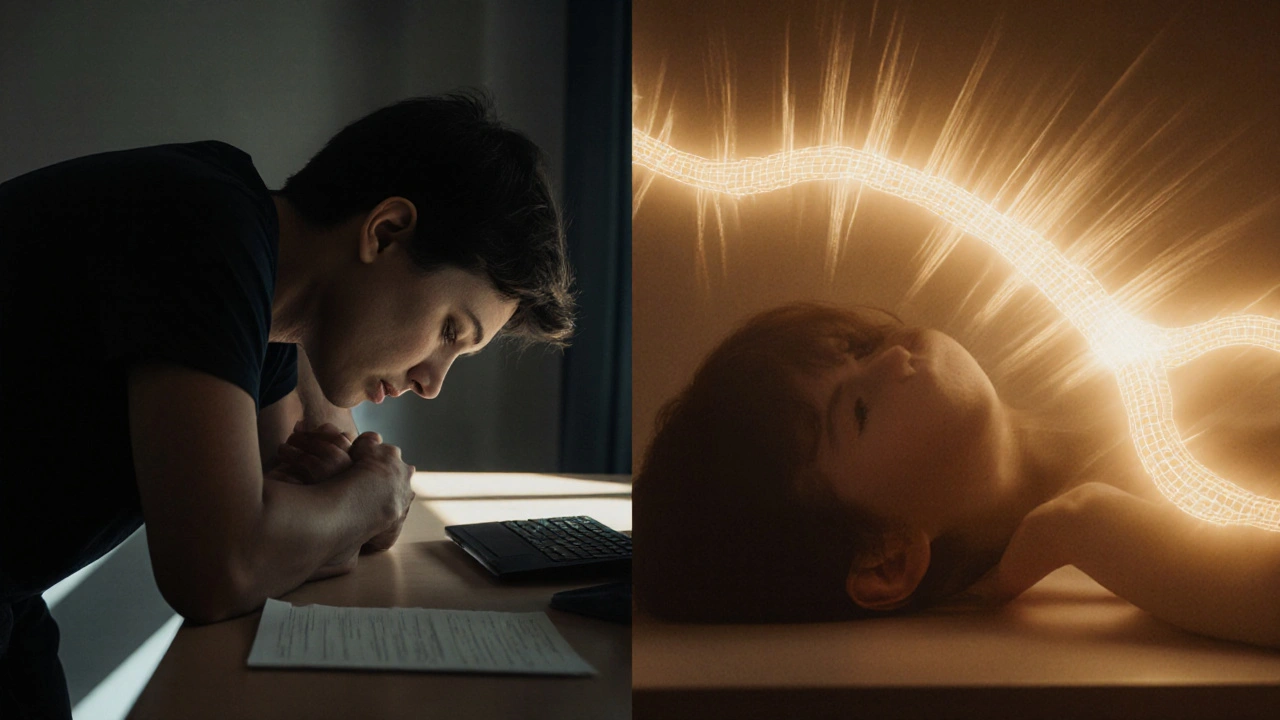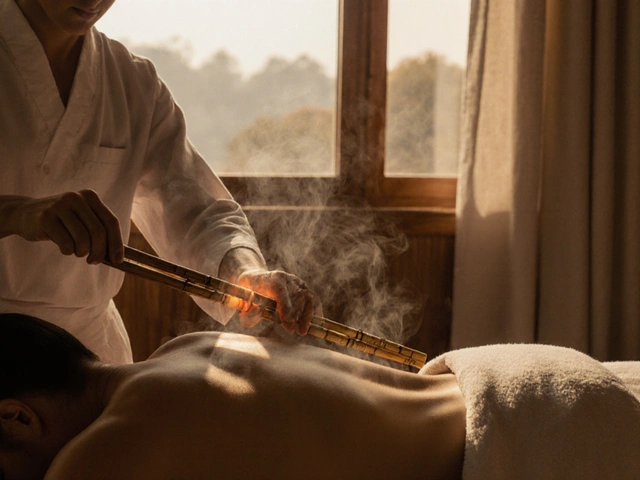Ortho-Bionomy: The Ultimate Solution for Stress and Pain

Ortho-Bionomy Self-Care Position Finder
Find Your Comfort Position
Ortho-Bionomy teaches that your body knows how to heal itself. This tool helps you discover gentle positions of comfort that reduce pain and stress by listening to your body's natural signals.
When your body finds a position of comfort, it signals your nervous system that you're safe. This triggers relaxation and reduces pain signals.
Why it works: This position helps reduce tension in your by allowing your body to find its natural, relaxed state.
Hold this position for 30-60 seconds while breathing slowly. You may feel a gentle release of tension or a sense of calm.
Track your comfort journey:
How to track: After each session, note how much pain you feel (1-10 scale) and how long relief lasts.
What if the key to easing your chronic pain and daily stress wasn’t a deep tissue massage, a prescription pill, or even yoga? What if it was something so gentle, so quiet, that you might not even realize it’s working until your shoulders drop and your breathing slows? That’s Ortho-Bionomy.
What Exactly Is Ortho-Bionomy?
Ortho-Bionomy is a non-invasive, gentle bodywork technique developed in the 1970s by British osteopath Arthur Lincoln Pauls. It’s based on the idea that your body already knows how to heal itself-you just need to give it the right signals. Unlike chiropractic adjustments or deep massage that force movement, Ortho-Bionomy works with your body’s natural reflexes. It doesn’t push pain away. It invites it to relax.
The name comes from Greek: ortho (correct, straight) and bionomy (law of life). It’s not about fixing what’s broken. It’s about helping your nervous system recognize that it’s safe to let go. You lie fully clothed on a table while the practitioner gently moves your limbs into positions of comfort-positions your body already likes. No twisting. No popping. No pressure. Just subtle, slow, guided movement.
It’s not magic. It’s neurology. When your body feels safe, your sympathetic nervous system (the one that keeps you on edge) shuts down. Your parasympathetic system (the rest-and-digest mode) kicks in. That’s when healing begins.
How Does It Actually Reduce Pain?
Chronic pain isn’t just about tissue damage. It’s often your nervous system stuck in alarm mode. Even after an injury heals, your brain keeps sending pain signals because it thinks you’re still in danger. Ortho-Bionomy interrupts that loop.
Here’s how it works in practice: If your lower back hurts when you sit, the practitioner won’t press on it. Instead, they’ll gently guide your spine into a position where the pain disappears-even if it’s just for a second. That’s your body saying, “Ah, this feels better.” The nervous system notices. It relaxes. And the pain signal weakens.
Studies on similar gentle neuromuscular techniques show measurable drops in cortisol (the stress hormone) and increased heart rate variability (a sign of nervous system balance). While large-scale clinical trials on Ortho-Bionomy are limited, decades of practitioner reports and patient testimonials consistently show reductions in chronic pain from arthritis, sciatica, migraines, and fibromyalgia.
One woman in her 60s with 15 years of degenerative disc pain tried everything-physical therapy, injections, acupuncture. Nothing stuck. After three Ortho-Bionomy sessions, she stopped taking her daily painkiller. Not because the disc was fixed. Because her body finally stopped screaming.
Why It Works for Stress and Anxiety
Stress isn’t just in your head. It lives in your muscles, your breath, your posture. When you’re anxious, your shoulders creep up. Your jaw clenches. Your chest tightens. Your body stays in fight-or-flight mode-even when there’s no tiger in the room.
Ortho-Bionomy doesn’t tell you to breathe deeper or meditate more. It shows your body what relaxation feels like. In a session, you’re guided into positions that mimic natural rest states-like the way a cat stretches after a nap. Your nervous system doesn’t need to be convinced. It just needs to remember.
People who suffer from burnout, PTSD, or generalized anxiety often report feeling “lighter” after just one session. Not because they were hugged or talked to. Because their nervous system got a new signal: You’re safe now.
Unlike talk therapy or mindfulness apps, Ortho-Bionomy works below the level of thought. It speaks the language of the body-movement, sensation, safety.
Who Can Benefit From It?
Ortho-Bionomy isn’t just for people with chronic pain. It’s for anyone who carries tension.
- Office workers with neck and shoulder stiffness from hours at a desk
- Parents with sleep deprivation and constant physical strain
- Athletes recovering from overuse injuries without more aggressive rehab
- Elderly individuals with joint stiffness who can’t tolerate deep massage
- People with autism or sensory sensitivities who find traditional therapies overwhelming
It’s especially powerful for those who’ve tried other therapies and hit a wall. If you’ve been told, “It’s all in your head,” or “You’ll just have to live with it,” Ortho-Bionomy offers a different path. It doesn’t deny your pain. It respects it. And that’s often what your body needs most.

What Happens in a Typical Session?
A session lasts 60 to 90 minutes. You stay fully clothed. No oils. No undressing. You lie on a padded table, sitting, or sometimes even in a chair-whatever feels most comfortable.
The practitioner starts by listening. Not with their ears. With their hands. They gently touch areas of tension and wait. They’re not looking for tightness to fix. They’re looking for the position where the tension eases-even slightly.
Then comes the magic: They move you into that position. Not forcefully. Just enough to let your body say, “Oh, this feels right.” You might feel a tiny shift, a sigh, a warmth. That’s your nervous system resetting.
There’s no pushing, cracking, or stretching. If you feel discomfort, you tell them. They adjust. You’re in control. That’s part of why it works so well for trauma survivors and highly sensitive people.
By the end, you might feel a little spaced out. That’s normal. Your brain has been in overdrive for so long, it doesn’t know how to shut off yet. Give yourself time. Drink water. Don’t rush into a meeting or a workout.
How Many Sessions Do You Need?
There’s no magic number. Some people feel a shift after one session. Others need three to five. It depends on how long your body’s been holding onto stress.
Think of it like rewiring a circuit. If you’ve had chronic pain for years, your nervous system has been running the same faulty program on repeat. Ortho-Bionomy doesn’t delete the program overnight. It gives you new code-slowly, gently.
Most practitioners recommend starting with weekly sessions for 3-4 weeks, then spacing them out. After that, monthly tune-ups keep things balanced. It’s not a cure. It’s maintenance for your nervous system.
How It Compares to Other Therapies
| Therapy | Pressure Level | Client Control | Best For | Side Effects |
|---|---|---|---|---|
| Ortho-Bionomy | Very light | Full control | Chronic stress, trauma, sensitivity | None |
| Deep Tissue Massage | High | Partial | Acute muscle knots | Soreness, bruising |
| Chiropractic Adjustment | High (forceful) | Low | Spinal misalignment | Temporary dizziness, soreness |
| Physical Therapy | Moderate to high | Moderate | Post-injury rehab | Increased pain if overdone |
| Acupuncture | Minimal | Partial | Energy flow, headaches | Minor bruising |
Ortho-Bionomy stands out because it’s the only one where you never have to push through pain. You don’t need to be strong, flexible, or brave. You just need to be willing to let go.

What to Look for in a Practitioner
Ortho-Bionomy isn’t regulated everywhere, so training matters. Look for someone certified by the Ortho-Bionomy Association (U.S. or UK), or a recognized international body like the European Association of Ortho-Bionomy. They should have at least 300 hours of training and supervised practice.
A good practitioner won’t promise miracles. They’ll explain how the nervous system works. They’ll ask about your history-not just your pain, but your sleep, your stress, your emotional state. They’ll respect your boundaries. If they push, they’re not practicing Ortho-Bionomy. They’re doing something else.
Can You Do It Yourself?
Yes-and many people do. Ortho-Bionomy includes self-care techniques you can use at home. The simplest one: When your shoulder hurts, gently move it toward the position where the pain lessens. Hold it there. Breathe. Don’t force it. Wait. Let your body find comfort.
Another: Sit on the floor, bend your knees, and let your spine curl into a ball. Don’t try to straighten. Just relax. Stay there for a minute. Your spine will naturally uncurl when it’s ready.
These aren’t stretches. They’re invitations. Your body responds to safety, not effort.
Final Thoughts: It’s Not About Fixing. It’s About Listening.
Ortho-Bionomy doesn’t fix your back. It helps your back stop fighting. It doesn’t erase your anxiety. It reminds your nervous system that it’s okay to rest.
There’s no equipment. No drugs. No complex routines. Just quiet, gentle movement and a whole lot of listening. If you’ve tried everything else and still feel stuck, maybe it’s not your body that’s broken. Maybe it’s just been screaming for someone to finally hear it.
Give it a try. Not because it’s trendy. But because it’s gentle. And sometimes, that’s exactly what healing needs.
Is Ortho-Bionomy safe for people with serious medical conditions?
Yes. Because it’s so gentle and non-invasive, Ortho-Bionomy is safe for people with osteoporosis, cancer, recent surgery, or neurological conditions. Practitioners adapt every movement to your limits. Always inform your practitioner about your medical history so they can tailor the session. It’s not a replacement for medical care, but it can support recovery and reduce side effects from treatments.
How is Ortho-Bionomy different from Reiki or energy healing?
Ortho-Bionomy is physical, not energetic. It uses actual movement and tactile feedback to communicate with the nervous system. You’re not lying still while someone waves their hands. You’re gently guided into positions your body already prefers. It’s grounded in anatomy and neurophysiology-not metaphysics. That’s why it works for skeptics and science-minded people.
Does insurance cover Ortho-Bionomy sessions?
Most insurance plans don’t cover Ortho-Bionomy because it’s classified as an alternative therapy. However, some HSA or FSA accounts allow reimbursement for pain management services. Check with your provider. Many practitioners offer sliding scale fees or package deals to make it more affordable.
Can children benefit from Ortho-Bionomy?
Absolutely. Children with sensory processing issues, ADHD, or developmental delays often respond well because the sessions are calm, non-threatening, and fully controlled by the child. Many parents report improved sleep, reduced anxiety, and less tantrums after regular sessions. Sessions for kids are shorter and often involve play-like movements.
How long do the effects last?
After one session, relief can last hours to days. With consistent sessions, the effects build. People often report that after four to six sessions, their body remembers comfort. They wake up with less pain, breathe deeper, and move more easily-even without thinking about it. It’s not temporary relief. It’s nervous system retraining.
Do I need to believe in it for it to work?
No. Belief has nothing to do with it. Your nervous system responds to safety, not suggestions. People who are skeptical often get the best results because they’re not trying to “make it work.” They just let their body feel. The technique works whether you think it will or not.
If you’re tired of treatments that hurt more than they help, it’s time to try something that doesn’t ask you to push through pain. Try Ortho-Bionomy. Let your body lead. It already knows the way home.





